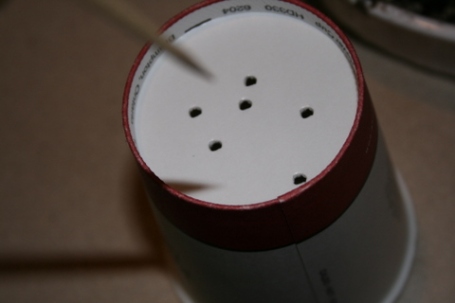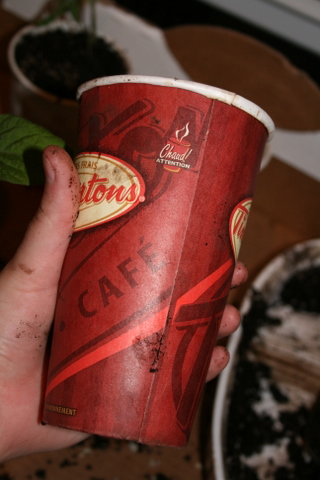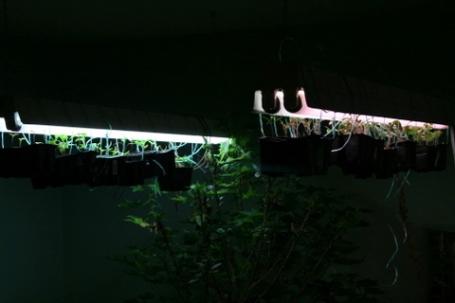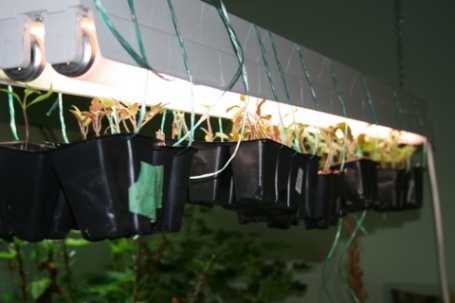Posts tagged ‘garden’
Business School Grad on Urban Farming
I have to admit, sometimes I feel a little crazy about my urban homestead obsession, and though I try very hard to encourage the people around me to grow food (it’s so easy!), I know that sometimes the scale that I’ve taken it to can be a little intimidating. That’s why I get excited when my web developer friends grow heirloom tomatoes on their apartment balcony (Gavin: “When the tomatoes started growing, I though it was a diseased growth. It didn’t occur to me that tomatoes start out as these little green things”).
My friend Alec, a business school grad, has been courting my garden for some time now. Last summer, we took him home to show him what we were growing. He was excited about it because, as he says, he spends a lot of time thinking and reading about peak oil/climate change/sustainability issues, but he felt kind of powerless to really do anything about it. But again this year, he was still talking about gardening, because he hadn’t felt prepared to start his own. (Trust me, it’s not as hard as you think!) So this Canada Day, I invited him to join us for a day of gardening. He gave me 9 hours of labour on a holiday, and sent me an eloquent thank-you note, as if his slave labour hadn’t been a tremendous help:
I realized it’s been almost two weeks since we spent the day gardening, and I never really followed up to say thanks. So…..thanks. It really was kind of you to take the time to share with me some of your knowledge about a very important skill for the future. I must admit, whether I was thinning radishes or planting tomatoes, there was a voice inside my head quietly asking “what the f@*! are you doing dude?!?” Mind you, that same voice was basically saying the same thing when I was being force-fed business school propaganda. (As I’m sure you can tell, I have a tough time hiding my bitterness with the mainstream economic/business establishment – another reason I’m seeking a positive alternative.) In any case, I’m glad I took the time to learn something new, and that you were willing to help me along my way. No doubt I have much still to learn, but the planting of that metaphorical seed was definitely a step in the right direction. I’d love to help out again sometime if you guys would be down. Anyhow, I just wanted to say thanks again. I know it probably wasn’t a big deal for you guys, but it was definitely a small, but meaningful step in the right direction for me.
Cheers ,
– Alec
Man-Eating Plants
You may have thought that you were in charge, but your garden wants to eat you.
Seriously, the human body provides an excellent source of nutrients to your plants that you may not have considered:
Hair: chemical (dye/perm) free hair provides an excellent source of slow release nitrogen to your soil.
Finger/toenails: Put your clippings in the garden. They’re a source of calcium.
Blood: an excellent source of nitrogen. If you use a menstrual cup, or have a nasty blood spill to clean up, empty it out in the garden. Of course, blood meal works too.
Bones: bones are very high in calcium and phosphorous, which is essential for healthy root and fruit development. If you don’t want your plants to eye your limbs hungrily, I recommend bone meal.
Urine: is a convenient nitrogen-packed liquid fertilizer. It’s safe to pee directly on most mature plants, but it’s easier and safer if you just pee in your watering can and dilute it. The smell of your territorial markings will also help deter animals that want to steal your food.
Feces: Human waste is sold as “malorganite” in garden stores. General knowledge tells us that we should never use manure from animals that aren’t vegetarian, but no one told the guys who make this shit. What you should never use is waste from animals that eat chemicals that they can’t pronounce, and are passing things like fluoride and lead through their bodies. Did you hear about the lead contamination in the Michelle Obama’s organic Whitehouse garden? From malorganite being used on the lawn. It’s a great way to poison yourself twice: the lead that passes through your system can be absorbed by your plants so that you can eat it again. yum! That being said, vegitarians can make excellent use of composting toilets for an eco-friendly way to flush, to recycle those waste nutrients.
Garden Warfare: Deer
One of my gardening clients has a terrible deer problem. The deer have a taste for her phlox. The entire property is surrounded with wild phlox, but the deer would rather destroy the domestic ones in her garden. They just have a bad attitude.
I told her that Irish Spring keeps deer away. It’s not surprising, given the smell. I would stay away too. Just use an old stocking to tie the soap to shrubs that are a problem. She wasn’t interested in decorating her garden with soap (again, I don’t blame her). You can also string fishing line around the garden, because it confuses the deer when they walk into it. But if you’re like me, you’ll probably also walk into it yourself.
Human hair is also a good solution. Sprinkling it around the garden means that the deer are deterred by human scent, and your plants get nitrogen. But unless you have a deal with a barber, or spend a lot of time cutting your hair, a fresh supply of human hair is hard to come by.
The thing that finally worked was so simple it’s absolutely brilliant. She cut a small hole in a little garbage can, put a radio inside with an outdoor extension cord running through the hole, and tuned it into the CBC. Unlike some fear-based deterrents, the diverse range of music and talk radio changes enough to keep the deer away. For now, anyway.
Hot Season Lettuce
R asked me the other day whether it was too late to plant lettuce. The short answer is yes, it will bolt in the heat. Bolted lettuce is terrible. The long answer is, you can get around that. Here’s some tricks:
1. Give it lots of water. Lettuce is mostly comprised of water, so water frequently to keep it in shape. By frequently I mean daily, at least.
2. Give it nitrogen. Lettuce likes fertilizer. You can apply a balanced composted manure, or for a bigger nitrogen kick, apply fish meal or blood meal. Interplanting lettuce with soybeans is good too, so you can enjoy edamame and nitrogen fixing from a plant that will be roughly the same height. Another surprising nitrogen source is hair. Finely chopping up the (un-dyed/permed) hair from your comb and pets and mixing it into the soil is a good way of adding nitrogen. On another note, your soil loves toenails, but the wonders of human soil additives are best saved for another post.
3. Eat your sprouts. Make sure you are thinning your lettuce crop as it grows, so that the plants have room to grow. Lettuce can’t bolt before it’s mature, so eat salad every day. With leaf lettuce, you can also harvest single leaves from the plant, so that it continues to produce new leaves without having a chance to reach its bolting stage. This reminds me of another tip:
4. Plant leaf lettuces, not head lettuces. Head lettuces are harder to grow, even in the appropriate season. Plus, there are more fun varieties. Check the seed packets for varieties that say they’re resistant to heat or bolting.
4. Shade it. Keep it out of full sun, because lettuce isn’t a fan of summer weather. If you’ve ever moved a plant into natural sunlight without adjusting it first, you’ve probably seen that plants can get a sunburn (whitening of the leaves). Lettuce is the Irishman of the veggie patch: it sunburns easily, and then it’s cranky. Either plant it in part shade, install a shade cloth, or plant tall things to shade it.
5. Use containers. A soil-less potting mix retains water better than earth, so container planting can be a good solution if you’re more neglectful. Just remember to plant it in clay, not plastic, so that the roots stay cool.
You asked Google, I answer:
I’ve noticed a lot of people are arriving here at Living Lime on search terms with some variation of “buttercrunch lettuce” and “lime” (as in ground limestone for the garden). Hopefully I can help you find what you’re looking for:
1. Leaf Lettuces:
– are delicious, but have to be planted in cool weather, and give them frequent, short watering (most other plants want infrequent deep watering). If leaf lettuces bolt (suddenly grow tall and flower), you may as well just let them seed and try again, because they’ll be bitter.
– How to harvest? pick it. Early in the morning is the best time, whenever the leaves are big enough to eat.
– If you plant the seeds close together, then you can thin the lettuce patch by eating it. This will help you grow more in less space. Even better is if you mix a bunch of leaf lettuce seeds together in one spot, so you get a tasty salad mix.
– companion planting: beans, kohlrabi carrots, alliums(onion family), radishes. Avoid celery, cabbage, cress, parsley.
2. Horticultural lime:
– is excellent for raising the Ph of your soil for alkaline loving plants. But unless a soil test has told you your soil is too acidic, you probably don’t need it for this use. Your plants like soil that’s full of organic matter, even if it makes the soil more acidic. I wouldn’t recommend applying lime unless you’ve done a soil test, because you don’t want to be mucking about with your soil’s pH if it’s already perfect. It can damage plants and drinking water supplies.
– is often used for adding calcium to the soil, which is particularly useful for preventing blossom end rot in peppers, tomatoes, and eggplants (the fruit gets sunken dark patches of rot on the bottom). More likely, your peppers just need more consistent water conditions, as peppers have difficulty taking up nutrients if they go through periods of drought. Bone meal delivers calcium but is also high in phosphorous (= strong roots), so I’d rather use that than lime. I’ve also read that that you can put a Tums tablet in the bottom of the hole when you plant, as the calcium is more available in that form, and it only goes where you need it.
-lime is best applied in the fall, because it needs time to break down. Adding it in the spring isn’t really going to help with calcium levels for your new plantings.
-If you’re going to use lime, Don’t ever apply lime mixed with a chemical fertilizer. Even with natural fertilizers, it’s best applied at a different time, because nitrogen + lime = ammonia + negated nutritional benefit to your plants. Also, don’t apply lime two years in a row, or you’re just asking for trouble.
-If you’re sure you want to apply lime, use a face mask. Trust me, you don’t want it in your lungs.
How To Grow Uber Tomatoes, even when you start them too early
…by using recycled coffee cups to maximize root size. Every year I start my tomatoes in February. I don’t have a south facing window–I am totally reliant on shop lights to help them grow. But instead of being leggy, my tomatoes are crazy drought-proof beasts that take over the world. Last year, my Matt’s Cherry tomato grew about 9 feet wide, and the neighbours had to cut it back just to figure out where the fence was so they could park their car. That’s because the root ball was deep enough to support it. My secret is using recycled coffee cups to help gradually build up the root ball.
Step 1. Get everyone you know (and their office) to collect coffee cups. Sort them by size, because you will want to start with the small ones. Poke drainage holes.

Step 2. Remove your leggy tomato seedling from the cellpack (I plant all my seeds in cell packs recycled from past years, because most greenhouses won’t recycle them), and place at the bottom of a small cup. See the first leaves at the bottom? Carefully pinch those off.

Step 3. Bury the tomato up to where it branches, stem and all. Around the root ball, you can use compost to give it a healthy start, but when you are burying the stem, a soil-less potting mix is best. (I prepare my potting mix by soaking it first, to make sure it has absorbed plenty of water.) This is how deep you should plant it.

Roots will grow out of the part of the stem that you burried, to become part of the ever-growing rootball.
Step 4. When the tomato grows up out of the pot again, remove it from the small cup, put it in the bottom of a medium sized cup, and bury it up to the branch again. (In these stages, you can make a doughnut of compost around the outer edges of the cup, and use potting mix for the rest.)

Repeat until you have a root ball as deep as extra large coffee cup. You can keep moving them up into larger planters, but by XL I run out of space to keep all my seedlings.

Using coffee cups also makes it easy to give away tomatoes to friends and neighbours. Share the heirloom love.
When it’s finally safe to plant everything outdoors, I’ll show you how to use drought-proof planting to make your tomatoes (and other plants) survive between rains without the need for watering.
Shoplights, My Seed-Starting Sun-sub
I have a grow-op in my basement. It’s not what you think. I have more than 60 baby pepper plants, 100 baby tomatos, 3 hibiscus, 5 brugmansia trees, 2 abuliton, jacobinias, artichokes, 5 varieties of basil, a goji berry yearling, and many many other beautiful or edible plants that would be dead if I left them outside for the winter. I grew a pineapple in my basement. If I used high pressure sodium grow lights, the utility bills would kill me. Instead, I have 5 banks of fluorescent shop lights with wide spectrum bulbs on a 16 hour timer (2 of those banks are borrowed just for starting my veggie seeds). They keep my plants happy without using a lot of power.
I just tie my cell packs of sprouted seedlings directly to the lights to make sure they get enough ‘sun’. If I don’t remember to lower them as they grow, they bend around the bulbs in funny ways, but they never burn, and it’s enough light to keep them happy.


I already started hardening off my seedlings 2 weeks ago, because the end of may is way too long to wait to plant them!
Architecture of Urban Farming
The City of Vancouver, so much more than a “city that could be,” has developed Climate Change Action Plans and an EcoDensity Charter to do something to make things better. The city recently partnered with The Architectural Institute of British Columbia to present Form Shift: an architectural ideas design competition to support their goal of becoming “the greenest city in the world”.
Urban agriculture ideas were big in the competition. The Harvest Green Project By Romses Architect recieved an honorable mention in the competition, which saw urban farming as a way to help the city eat more sustainably:
To a certain extent, we have seen 20th century town planning disregard the importance of food and farming, and urban development has virtually eliminated agriculture in our cities….Incorporating urban farming prominently into the fabric of the city, and in a synergistic mixed-use development integrated with transit, is a way to re-assert the cultural and environmental importance of locally produced food to the health and sustainability of the city and its residents.

The Community Catalyst submission by Garon Sebastien and Chris Foyd also received honorable mention. Their approach was simple:
Community gardens have proven hugely successful in fostering neighbourhood exchanges and building a sense of community.

That’s what we’re hoping for with the River Forks Community Garden, which has taken more than 3 years of fighting to push into existance. Now we’re just waiting for the city to do their thing, so we can do ours. The suspense is killing me!
via City Farmer.
Rabbit Poo!
Today I made friends with a woman who breeds rabbits for use as pets. Because I came to take her poo.
What would I want to do with several bins of rabbit poo? Because you can’t run a closed loop system (self sustaining) garden without animals to help you fertilize, and rabbit manure is the greatest fertilizer made in this part of the world (next to worm castings, but I’d need a LOT of worms). Plus, it’s the only manure that doesn’t need to be composted first. And the roll-y pellets don’t smell. Here’s how rabbit manure stacks up against other standard manures:
Rabbit manure: Nitrogen(N): 2.4 Phosphorus(P):1.4 Potassium(K): 0.6
Most concentrated of animal manures in fresh form. No composting needed.
Cow manure (dairy): N:0.6 P:0.2 K:0.5
Often contains weed seeds, should be hot composted.
Steer manure: N:0.7 P:0.3 K:0.4
Often contains weed seeds, should be hot composted if fresh.
Chicken manure: N:1.1 P:0.8 K:0.5
Breaks down quickest of all manures, but it will probably burn your plants (and it reeks) so it should definately be composted.
Until I get out of the city, I’m very lucky to have a new rabbit breeding friend!
and finally, because I had never heard of Peruvian sea bird manure until today:
Peruvian Seabird Guano (pelletized): N:12 P:12 K:2.5
“Legendary fertilizer of the Incas. Use in soil as a long lasting fertilizer, or make into tea (1 tsp pellets to 1 gallon water).”
There’s lots to learn about fertilizer here.
Eco-Pirates Seize Raven’s Ait
Back in February, an activist who goes by Nick Revolving, 28, was taking a leisurely boat ride in the Thames and realized that an island that once served as a venue for weddings and conferences was lying vacant as a result of the economic downturn. So he decided to do something productive with it. So he invited his friends, and with an aim to “to give it back to the people,” they’ve been squatting on it in a sustainable model commune, complete with a tree-house and raised-bed permaculture gardens.
The goal of the group is to “transform the island into an eco conference centre, aimed at showcasing green ideas and promote sustainable development” In the hopes of making it official, they’ve submitted formal plans for their “sustainable island” to the local council, but the council members are unwilling to negotiate while the squatters are still on the land.
In fact, they’ve issued an eviction notice, so my understanding of squatters rights in England is obviously flawed. It seemed to work for the Geurrilla Gardeners. Interesting though, that although the island has been vacant since November, council urgently wants them off because “there are companies interested” in the land. The community’s behind these eco-pirates, saying that “They’re serving the community”, but the group says it will leave in eight weeks time. Shame. I wonder what the consequences of ignoring an eviction notice are?
Read the article in Yahoo News. Or better yet, visit the Raven’s Ait website to read about their plans and show your support.
UPDATE:
from the Ravens Ait Facebook page:
The island was evicted by a large armed police operation in the early hours of Friday May 1st 2009.
The council are now paying for 24 hour security with a continous rolling presence of around 10 guards (at an estimated cost of £2000 a day of taxpayers money) while they try to sell off the island.
We think this is a gross waste of taxpayers money that could have been spent supporting our proposal for a community centre. Of course the island is no longer accessible to the public either, so effectively taxpayers are paying vast sums of money to keep themselves off the island while the council prepares to sell this historic piece of common land to a hotel or property developer
What a terrible lack of vision. The group hasn’t given up, though. They’re appealing to the media to help them raise £1.5 million “to save this island as a community facility for all generations to enjoy into the future.” I’ve asked them if they have a paypal account, and will post the link if they have one, for anyone who wishes to make a donation.

